Juror: Kerry Brougher
Curator: Hank T. Foreman
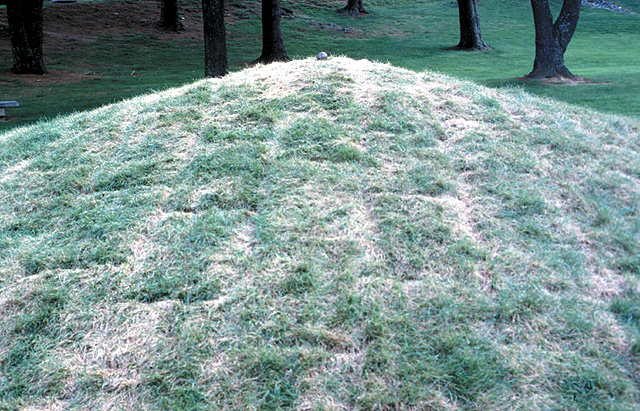
David Tillinghast, The Stinging Bee. 2002 / 16th Rosen Sculpture Competition Winner.
Sculptures
-
The Stinging Bee1st Place
The Stinging Bee
David Tillinghast
Seneca, South Carolina
Earth, steel ball, bronze, and hollow space. Site specific.
On display now as part of the Rosen Sculpture Loan Program
Note: The title for the piece comes from a folk ballad by the same title from I.G.Greer, Boone, Watauga County, in 1915 or 1916. It is a variation on the popular theme, the lover’s lament.
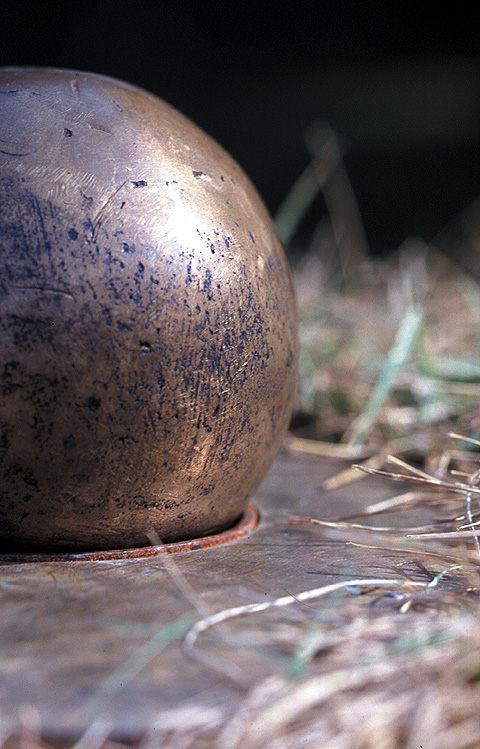
Artist statement
I was immediately attracted to the site between the music and math/communications buildings, the empty space of the large lawn. Looking up from the center of the lawn, one has the feeling of being surrounded, by buildings and then by the mountains. I kept thinking of the practice rooms inside the music building, the sounds emanating out into the halls and then the sounds of old songs from Appalachia and finally the feeling that deep in the rock of the mountain there is a sound. The valley is a hollow chamber full of reverberations starting low down at your feet and moving upwards into the imagination.
FS.909 Barn
Rudy Rudisill
Gastonia, North Carolina
Galvanized steel
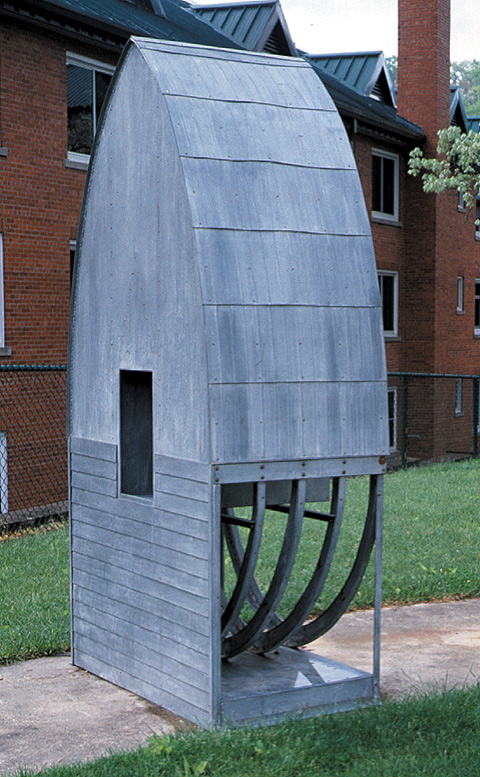
Artist statement
Vague overtures to the psychosexual ramifications of good bourbon and long drives in the country. Images on the shoulders of other images, moving always moving, in transition, transcending, changing, always changing. Drawn from visual memory; from subconscious connections with the relationship of physical elements to their symbolic implications; personal, cultural and historical.
Fleeting times, change, erosion, implosion, explosion, divestiture, mergers, rust and renewal. Common, uncommon, bland dull, repetitive, fresh, new, the same; only different. Microseism, mirror, challenge, threat; so many days so little time. Comfort cousin, discomfort sister, today never comes.
Freezing time, each image-specific to itself – a fragment of the continuum of production. Light scatters, gathers, darkness comes and goes. Eyesight, hindsight, blindside, upside down banana.
Grove
Gretchen Lothrop
Pittsboro, North Carolina
Stainless steel
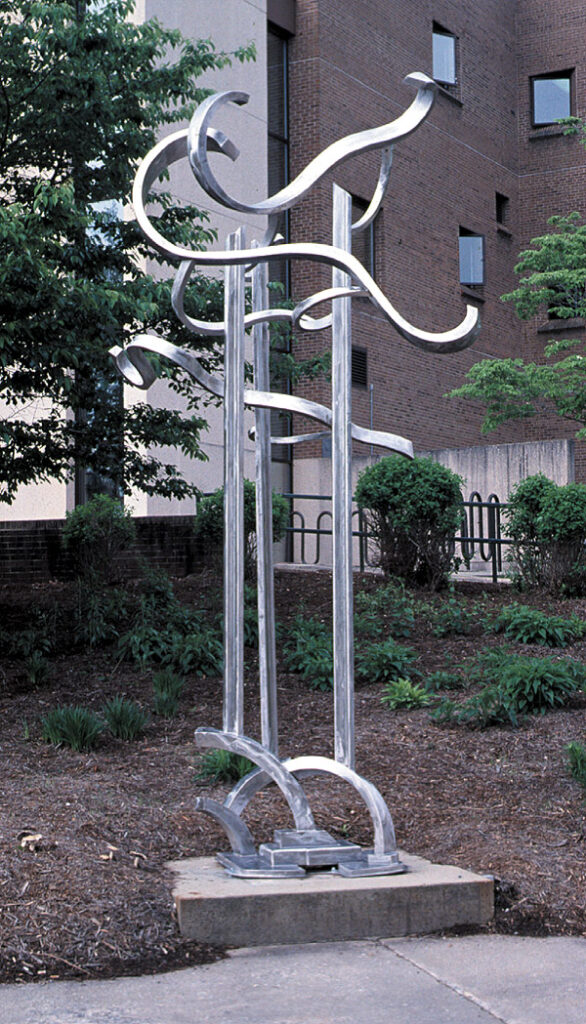
Artist statement
Cryptic allusion to artist bio: Gretchen Lothrop. Girl child. Yankee. Quixotic. Iconoclastic. Self- taught journey agent. Marginally literate. Worships metal and music. “who hath taught you so subtle a measure, in what hall have you heard it … ?”
The work: Flowerings of a desire to materialize intangible poetic instants using insistently permanent materials, especially stainless steel. A saraband with paradox: flying through an infinity of halves, the arrow never meets its mark, but the hero/warrior/poet is dead. “no … it just looks like it moves.” An attempt to affirm harmony (the continuum of dynamic instability reverbing soul stirrings.) in the face of chaos.
This piece: GROVE. A sacred place where Pan lives. Sanctuary. Solace. An oasis. “This is the place of my song-dream, the place the music played to me.”
Homestead
Susana Jones
Lanagan, Missouri
Cedar
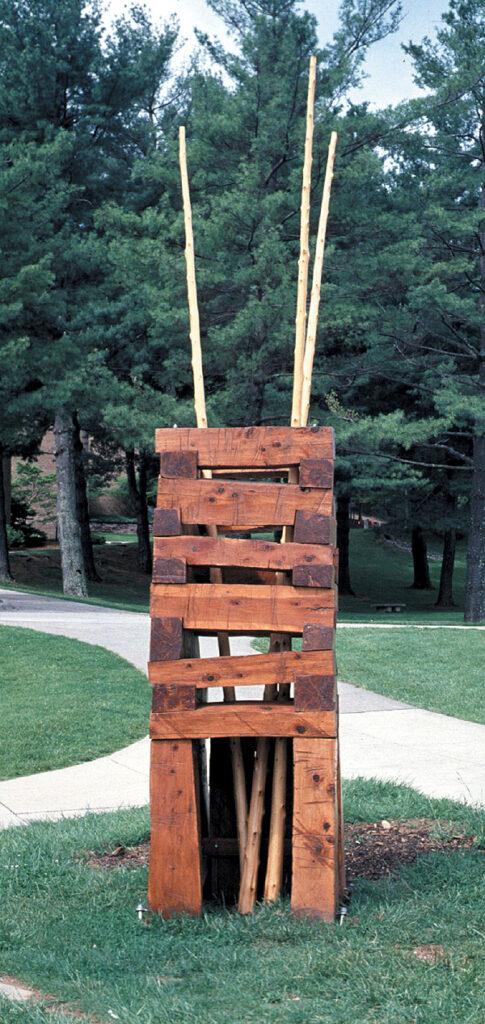
Artist statement
I have always been fascinated by survival in the wilderness. This interest must have been instilled in me through tales of adventure from grandparents who made the Oklahoma Land Run. As a child I dug cave homes and built tree houses and later as an adult spent over twenty years homesteading in remote areas of Central and South America.
Today my sculpture is an extension of these experiences and deals in particular with primitive structures. The works juxtapose references to Native American dwellings with pioneer homes lending symbolic meaning through the integration of form and materials. The materials of cedar and copper, malleable and warm in feeling, are nevertheless sturdy, resilient and symbolize survival.
Kazimoc XXX
Rodney Carroll
Baltimore, Maryland
Steel and stainless steel
“Along the Mount Royal Avenue median strip, monument offers a few striking sculptures constructed in a monument-minded manner. The best is Rodney Carroll’s Saint Patrick whose classically inspired cement column is topped with several gracefully coiling metal arcs. Carroll’s sculpture dramatically combines straight and curved forms, while commenting upon the surrounding neighborhood’s mix of classical and modern buildings” – Mike Giuliano, City Paper, July 25,2001.
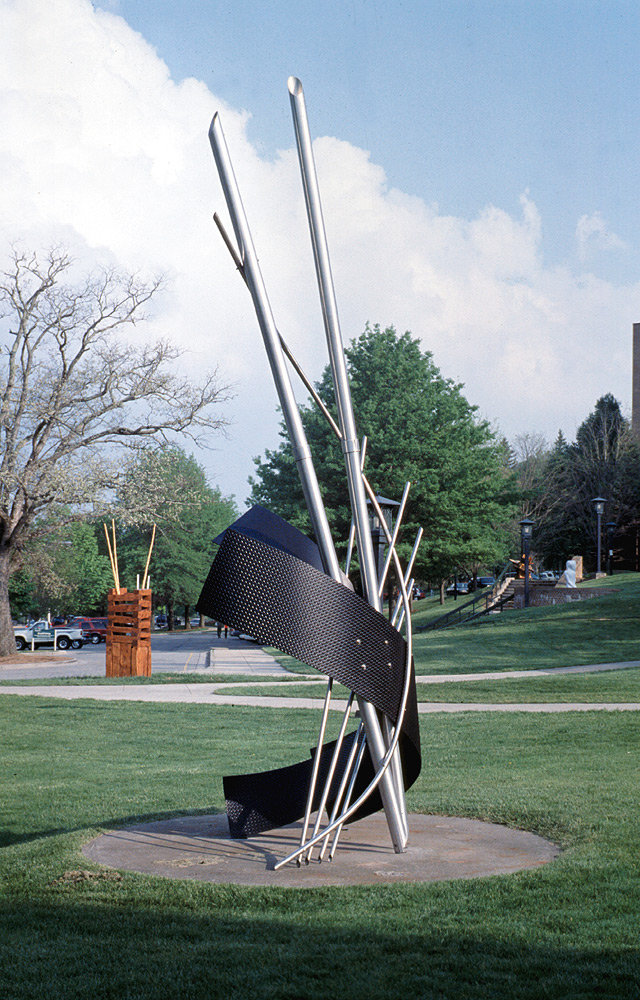
Artist statement
Through research in the use of line and plane to describe spatial energies, I explore human relationships. The sculpture may represent flight, dance, music, or architecture, focusing on how we move through space. Or, the sculpture describes a physiological moment in time as awareness and readiness. There are also bending parallel planes passing each other, pushing and pulling the surrounding space reflecting human internal and external relationships. Each element in the sculpture has a specific meaning and relationship to the other elements in the sculpture to complete the poem.
Currently, I am working on a series of sculptures about the effects of nature on flexible landscapes. These sculptures focus on the relationship of the winds energy in forming waves on the ocean and the shapes of the sand dunes.
My sculpture is almost always site specific with a response to considerations as understanding architectural and interior environments, pedestrian and client usage, the energy and flow of space, and safety. I have worked with a number of architects, landscape architects, developers, private collectors, governments, and communities on sculpture projects, and I welcome collaboration and input in the process.
Kyoto & Beyond
Wayne Trapp
Vilas, North Carolina
Cor-ten steel
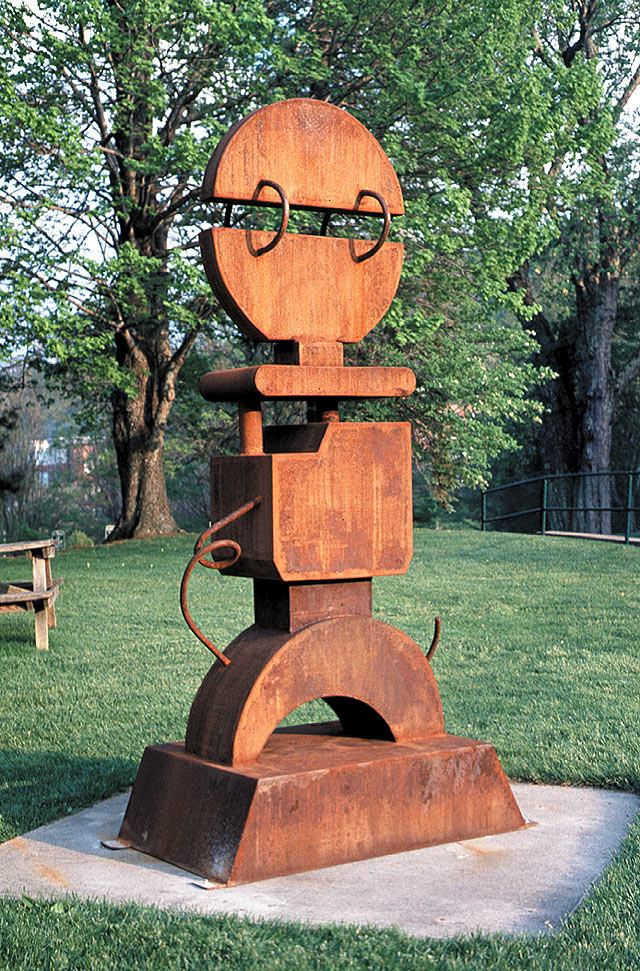
Artist statement
For me my art is a combination of many things … two of which stand out.
First, I’ve always believed it necessary to have dreams, at times bigger than life, and then to make those dreams become a reality (many of my larger corporate sculptures are examples.) To look at a raw piece of marble, or a sheet of steel, or an empty canvas and dream of what it could be, and then transform it from a dream, to a tangible form … this is what I live for.
Secondly, to always remain curious and surprised by all things and thoughts. This very curiosity propels me to invent, to make, to do, to create my art. There is a joy of innocent wonder that children possess which sadly enough we tend to lose as we grow older. Why and How and Wow??? Shedding all preconceived notions we learn to accept as adults, I try to look at only the colors, the light, the shapes of the world around me and turn this into art.
People often ask me, “what were you thinking when you made this painting, what does this sculpture depict?” That’s the beginning of curiosity and appreciation. Abstract art is a challenge to the senses. Often I’ll offer some sort of concrete description for the person who asks, but I’d much rather suggest that it’s totally an interpretation of whatever they simply feel, and see, and dream from my work.
About the Artist
Wayne Trapp, the sculptor, has worked in stone and steel for years, creating lavish–even colossal–outdoor pieces for corporate clients and smaller more particular pieces for his private clientele. His hands, his shoulders, are sore and sensitive with the scars of sculpting, but he can no more give it up than he can give up breathing. He avows that now he sculpts only by commission, but if a fine piece of stone presents itself or a flash of metal catches his eye or a woman turns her head just so, or if the moon is right, well… the dance begins. With unbridled energy and an insatiable passion for everything that crosses his path, Wayne forever seeks interchange, new ground, and a good time.
Wayne lives and operates his studio out of Vilas, N.C., and has works in extensive corporate, institutional and private collections across the U.S. and internationally.
For more information, visit www.waynetrapp.com.
Sundance
Hanna Jubran
Grimesland, North Carolina
Steel and paint
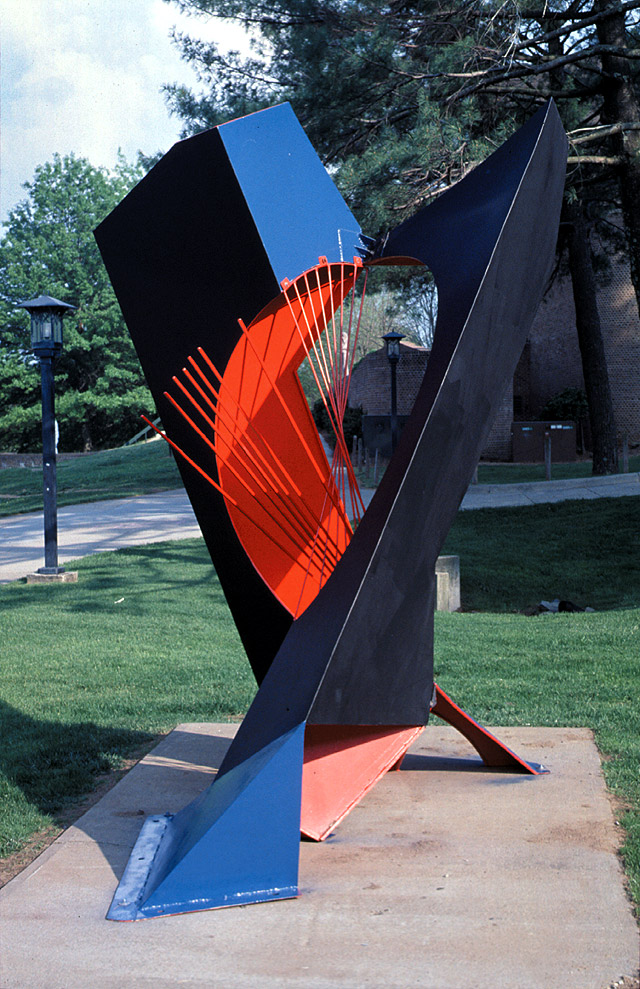
Artist statement
This sculpture represents growth, unity and warmth. The contrast of the natural green landscape and the red, blue and black surface of the sculpture creates a dynamic composition. The red color represents warmth and pride. The blue color signifies a view of spiritual immortality. Because of the visual balance created through specific placements of color and form, tranquility is achieved. The use of vertical and horizontal elements and texture reflects the earth’s environment. The round form represents the sun and the moon, the day and the night and the cycle of the seasons. The various radiating elements represents different formations that mankind has developed through cultivation of the earth.
About the artist
Hanna Jubran received his Master of Fine Arts degree in sculpture from the University of Wisonsin-Milwaukee in 1983, and he currently a Sculpture Professor at East Carolina University in Greenville, NC. Since 1996, he has participated in over 278 exhibitions, international symposia, national and international conferences, and over 50 lectures and workshops. His recent activities include a commission entitled “A Monument to a Century of Flight” in Kitty Hawk, NC. For every symposium Hanna has participated in, his sculpture has been kept as part of that town’s or organization’s permanent collection.
For more information, visit www.hannajubran.com.
Totemic XIX
Glenn Phifer
Boone, North Carolina
Welded aluminum and copper plated steel
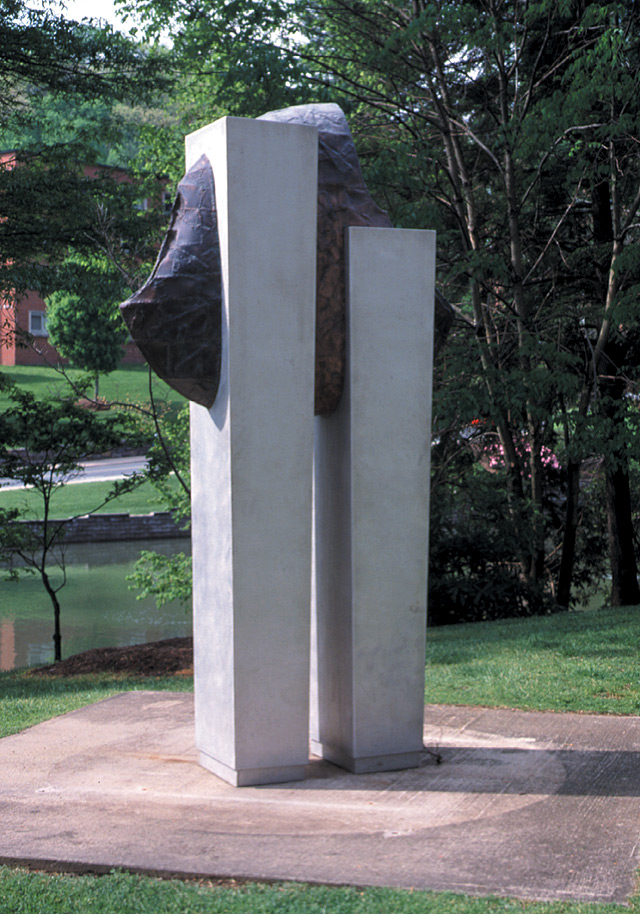
Artist statement
I have been exploring the concept of the totem-like structure as part of a group of outdoor sculptures, which have become my “Totemic Series” over the past several years. One common feature of all these works is that of combining an organic mass with a geometric form. Another aspect common to all the works is the combination of different materials, i.e. steel with stone, wood with metal, and the use of bronze and copper with aluminum. The result is a contrast in color as well as surface and texture of the finished pieces. This hopefully represents a part of our everyday life which is the combining of both refined and abstract shapes, forms and ideas.
Turbine
Ryan Goff
Boone, North Carolina
Found wood
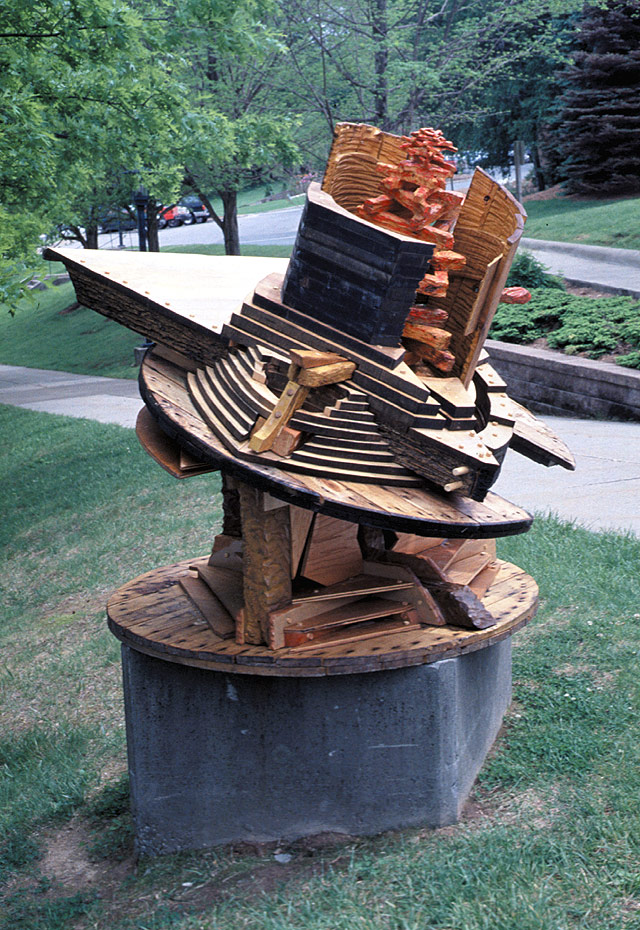
Artist statement
As a human, as well as an artist and craftsman, I am driven by passion, by naturalness and nature, by tribalism and primitivism, by ritual and process, by the greater good and ultimately by my life experiences. I consider every step of the creative process to be equally important as the finished piece, just as I consider every step of one’s life to be equally important as life in it’s entirety. All of my materials are gathered from the present environment that I find myself in, whether logs and stones from a forest, or industrial scraps from within the walls of a city. This act of scavenging allows me to stay connected with my surroundings as well as to reflect the aesthetic diversities of my materials whether coming from a natural or urban habitat. Also in my aesthetic I strive to reflect the past yet stay in balance with aspects of the modern, paying respect to our ancestors while applying this knowledge to our existence today. Working in the studio, I like to keep things fresh and spontaneous, letting my pieces evolve themselves through my interaction with my materials. As life itself, my work ultimately stems from constantly taking in experiences and ideas, generating this energy, and releasing it back out again through what I create, similar to those characteristics of a turbine.
A turbine is defined as, an engine driven by the pressure of steam, water, air, etc. against the curved veins of a wheel. As human beings, our souls are driven by the personal energies that surround us, curved against the veins of our experience. Walking through life daily, I strive to remain open to these personal energies, taking them in through my experience, letting them generate inside positively, only to be released once again back unto society for others to receive. In this sculpture, I wanted to create such a device, that is a “turbine” if you will, driven by those personal energies, which surround the viewer, only to be taken in, transformed, and released for the viewer to reflect upon and absorb.
Unity
Greg Mueller
Ely, Minnesota
Bronze coated steel
On display now as part of the Permanent Collection
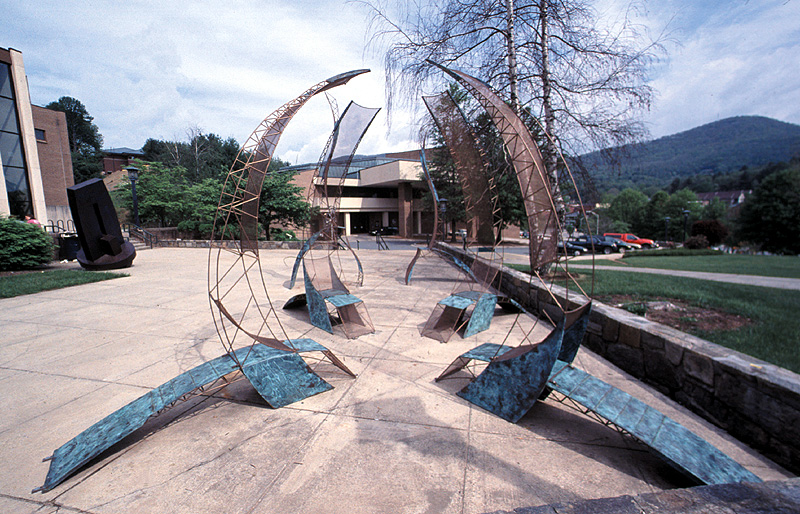
Artist statement
My work proposes that sculpture can be a focus for individual contemplation and community gathering. I embrace the Benedictine philosophy that values time for contemplation and encourages the individual to contribute to his community. This vision is made manifest in my most recent piece Unity. This thematically unified complex integrates architectural elements, (portals, benches) into sculptural and archetypal forms which represent the search for spiritual discovery. My intention is that sculpture can provide the viewer with a physical space, free from orthodox constraints, to engage in personal reflection or dialogue.
Juror’s statement
Marcel Duchamp once said that art didn’t interest him, artists did. Although it would be hard for a museum professional who loves objects to totally embrace such a philosophy, there is nevertheless something to Duchamp’s protest. What Duchamp meant was that it was the idea behind the object that was as important as the resultant object itself; for without those ideas, objects would in fact not be art.
It’s comforting to know that good ideas are still in abundance. They are certainly in evidence here at the 2002-2003 Rosen Outdoor Sculpture Exhibition. The entries in this year’s competition demonstrated a wide array of approaches to sculpture and were distinguished by compelling creativity. For a curator, this was enormously gratifying, but it also made the jurying process that much more difficult. Ultimately the diverse styles and sensibilities of the artists allowed for the creation of an exhibition that demonstrates the openness of sculpture today, the way it has expanded to include a variety of forms and materials – and above all, a multiplicity of ideas.
Kerry Brougher
Chief Curator
Hirshborn Museum & Sculpture Garden
Smithsonian Institute
Curator’s statement
As I prepared to write this essay, I grappled with how to approach this annual privilege from a new direction. Then my mind drifted back over past years; the artists, the great works, and the jurors whose decisions shaped the exhibition. It was then that it hit me. Each juror brings their own personal and professional history with them to the daunting task of choosing ten works from a slew of entries. Each of them have such insight and are able to help us see the world of outdoor sculpture through changed eyes. For this reason, I have chosen to revisit statements made by past jurors, and expand upon their relevance to our relationship with this unique brand of public art.
Jesus Bautista Moroles – 8th Rosen Juror states, “The finalists obviously represent a subjective viewpoint which echoes my personal belief that outdoor sculpture should encourage the viewer to investigate, to explore, and to interact.” This simple statement sheds a great deal of light on how Moroles understands his role as juror, and interprets the role of public art. His reference to “subjective viewpoint” and “personal belief” let us know that he not only acknowledges his background and experiences when viewing art, but recognizes that they are additional tools employed by him to relate to works of art. His view of outdoor sculpture is one of a dynamic dialogue. The work, by its very nature, should be an instigator of conversation between it and the viewer. Employing this understanding empowers us to each make our own relationship with public art and, while it might not be the same as the next person’s relationship, it is a valid way to begin living with a work of art.
In a statement equally freeing to the public art viewer, Bruce White – 10th Rosen Juror says, “The lingering notion that a ‘set of rules’ must exist to guide one to understanding the visual arts is as obsolete as saying one cannot listen to music or read a poem without a similar imposition. This is not to deny that the more one knows about anything the greater will be one’s appreciation.” Here White realizes that becoming an informed viewer is a good thing, but it is an ongoing process enhanced by viewing art often. One needn’t feel the pressure to learn everything at once. Visit a work of public art. Get to know it. Relate to it on that given day, and as you become more informed in the future your appreciation will deepen.
“(Sculpture)reminds us that we stand on the ground, that we walk with our legs, that we feel touch through our skin, that we track constant shifts of light with our eyes, and that with every breath and step our feeling of tension, relaxation, compression, expansion, sadness and joy.” These words by 11th Rosen juror Jackie Brookner place emphasis on the physical relationship between our bodies and public art. The simple fact is that we occupy the same three-dimensional space, and that outdoor sculpture brings the activity of viewing art to a more sensory level than other art viewing might provide. Added to this is the possibility of experiencing art over a long period of time. Because public art can become part of our daily lives, we are afforded the opportunity to view it through physical, environmental and our own psychological/intellectual shifts.
In his essay, 12th Rosen Juror John Perreault says, “The artwork whether indoor or outdoor, portable or site-specific, must speak to your heart as well as your intelligence.” Here Perreault emphasizes that art cannot be viewed through theory, concept or craft alone. Once embroiled in a dialogue with an artwork, just as with people, emotions come into play. I know, as a juror, on some occasions the first connection with a work can be based on an emotional response. It is then necessary to move past that response to deal with the construction at hand. This does not invalidate the emotional response, rather it tends to deepen the appreciation of well-designed and meaningful art.
“Occupying a space between architecture – representing our need to separate and protect ourselves from the unknown – and nature – the unknown with which we are always trying to reconcile – sculpture offers a creative potential through which we can understand our ever-shifting position in the world.” These words by 14th Rosen Juror Kathryn Hixson hint at the many roles outdoor sculpture can assume. These roles (like gathering place, relaxation space, and resting place) are often facilitated by the artwork’s placement within a specific environment. However, no matter what role the sculpture fulfills at any given time, it is this occupation of space between nature and architecture that draws people toward the work and an evolving experience.
Through the words of these jurors we begin to understand the complexities of outdoor sculpture. It is a part of our environment and initiates physical, intellectual and emotional dialogue. To participate in this dialogue, we should strive to become informed, however, we should also understand that the sculpture itself can often be the best teacher if we only listen. The task of the juror can seem overwhelming. The number of entries to be viewed, and then the number of entries that must be narrowed down to the chosen few often create difficulty. The fact remains; the process itself is not difficult. There is great joy in serving as a juror … the joy that comes from having the opportunity to dialogue with so much good art. It simply means coming to the work prepared to think, feel and learn, and, as these jurors have pointed out, that is all it really takes for any of us.
Hank T. Foreman
Director & Chief Curator
Turchin Center for the Visual Arts
About the curator
Hank Foreman serves as Assistant Vice Chancellor of Arts and Cultural Affairs as well as Director and Chief Curator of the Turchin Center for the Visual Arts for Appalachian State University. He obtained his M.A. in Art Education from Appalachian, having completed undergraduate studies at the University of North Carolina at Charlotte, with a concentration in Painting and Sculpture. His duties include the administrative responsibilities for An Appalachian Summer Festival, the Performing Arts Series, Farthing Auditorium and the Turchin Center for the Visual Arts.
During his tenure at Appalachian State, Foreman has taken part in the organization of numerous exhibitions, including the associated lectures, symposia, and publications. He has worked closely with the university’s Department of Art, and a wide variety of other campus and community groups, to make gallery resources available to all. One of his earliest exhibitions at Appalachian, Views From Ground Level: Art and Ecology in the Late Nineties, brought internationally acclaimed artists, historians, and critics to the campus and received national attention.
Foreman is also an exhibiting studio artist, and participates in regional and national conferences as a presenter and panelist.
A Special Thanks from the Curator
On behalf of An Appalachian Summer Festival, the Office of Cultural Affairs, and the Catherine J. Smith Gallery, I wish to thank all of the artists participating in this year’s competition and congratulate those chosen for the exhibition. Each year the Rosen Outdoor Sculpture Competition and Exhibition is made possible by the generous support of Martin and Doris Rosen. The Rosens are tireless supporters of the arts, and over the years, have given so much of themselves to ensure that the arts became a more integral part of our community. Their excitement and dedication serves as both inspiration and role model. I would like to thank our juror, Kerry Brougher, for his dedication and professionalism during the completion of his difficult task. I wish to thank my colleagues in the Office of Cultural Affairs, in the Art Department, and the students who participated in the installations. Special thanks to our designer – Michael Fanizza, photographer – Christopher Bledsoe, Program Assistant – Brook Greene, the folks at Boone Crane, and our student help – Sean Matthews. A heartfelt thanks to Jim Bryan – Grounds Superintendent, Evan Rowe – Safety Officer, the entire Grounds Department of the Appalachian State University Physical Plant, and to the grounds crew – who took the time out of their own busy schedules to help with installing David Tillinghast’s site specific sculpture. Their cooperation and expertise continues to make our campus a beautiful venue for outdoor sculpture.
– Hank T. Foreman
